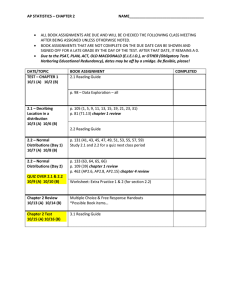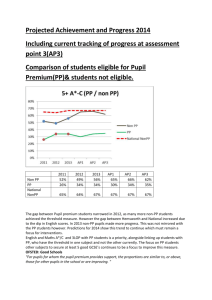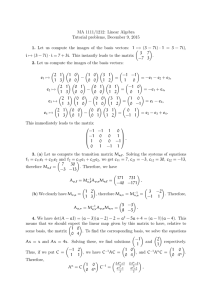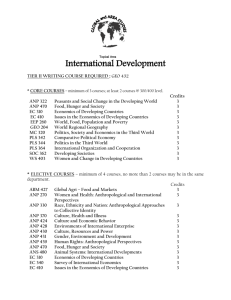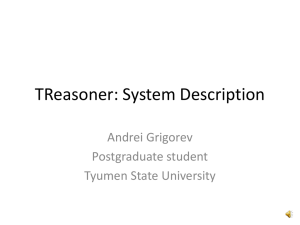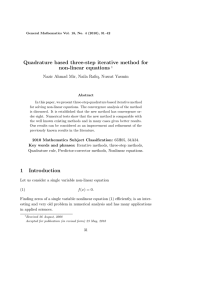Quadrature based two-step iterative s Nazir Ahmad Mir, Nusrat Yasmin, Naila Rafiq
advertisement
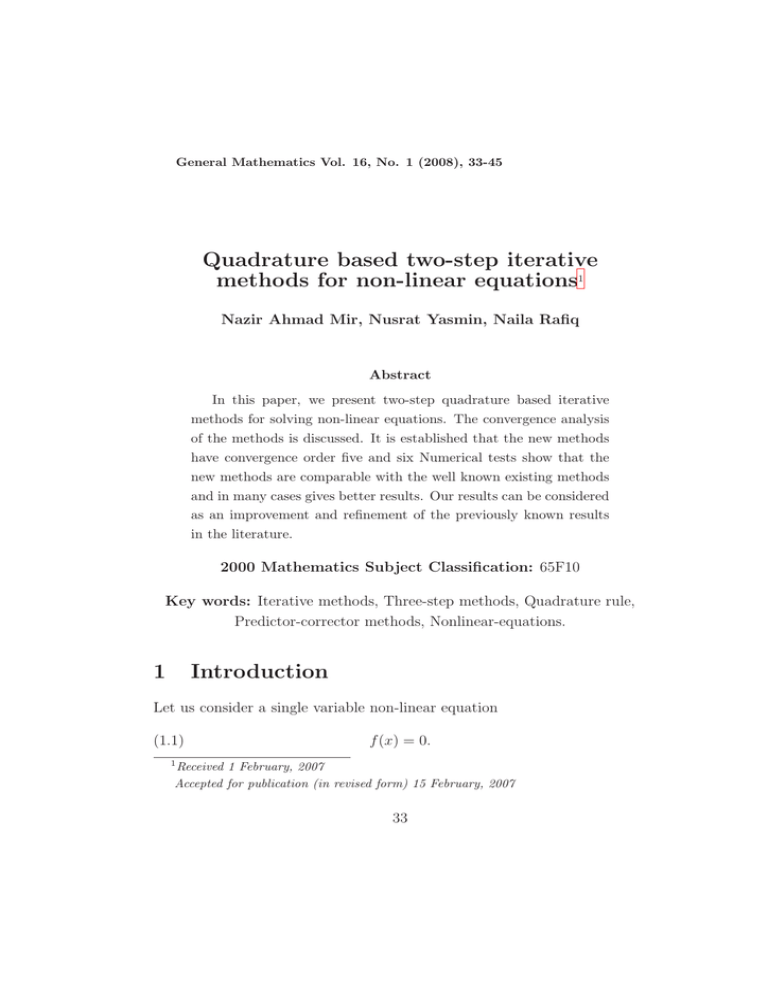
General Mathematics Vol. 16, No. 1 (2008), 33-45 Quadrature based two-step iterative methods for non-linear equations1 Nazir Ahmad Mir, Nusrat Yasmin, Naila Rafiq Abstract In this paper, we present two-step quadrature based iterative methods for solving non-linear equations. The convergence analysis of the methods is discussed. It is established that the new methods have convergence order five and six Numerical tests show that the new methods are comparable with the well known existing methods and in many cases gives better results. Our results can be considered as an improvement and refinement of the previously known results in the literature. 2000 Mathematics Subject Classification: 65F10 Key words: Iterative methods, Three-step methods, Quadrature rule, Predictor-corrector methods, Nonlinear-equations. 1 Introduction Let us consider a single variable non-linear equation (1.1) f (x) = 0. 1 Received 1 February, 2007 Accepted for publication (in revised form) 15 February, 2007 33 34 Nazir Ahmad Mir, Nusrat Yasmin, Naila Rafiq Finding zeros of a single variable nonlinear equation (1.1) efficiently, is an interesting very old problem in numerical analysis and has many applications in applied sciences. In recent years, researches have developed many iterative methods for solving equation (1.1). These methods can be classified as one-step, two-step and three-step methods, see [1-12]. These methods have been proposed using Taylor series, decomposition techniques, error analysis and quadrature rules, etc. Abbasbandy [1], Chun [3] and Grau [7] have proposed many two-step and three-step methods. In this paper, we present two-step quadrature based iterative methods for solving non-linear equations. We prove that the new methods have order of convergence five and six. The methods and their algorithms are described in section 2. The convergence analysis of the methods is discussed in section 3. Finally, in section 4, the methods are tested on numerical examples given in the literature. It was noted that the new methods are comparable with the well known existing methods and in many cases gives better results. Our results can be considered as an improvement and refinement to the previously known results in the literature. 2 The Iterative Method Weerakoon and Fernando [12], Gyurhan Nedzhibov [11] and M. Frontini and E. Sormani [5-6] have proposed various methods by the approximation of the indefinite integral Z x f ′ (t)dt, (2.1) f (x) = f (xn ) + xn using Newton Cotes formulae of order zero and one. We approximate, here however the integral (2.1) by rectangular rule at a generic point λx+(1−λ)zn with the end-points x and zn . We thus have: Z x f ′ (t)dt = (x − zn )f ′ (λx + (1 − λ)zn ), zn Quadrature based two-step iterative methods for non-linear equations 35 this gives (2.2) −f (zn ) = (x − zn )(f ′ (zn ) + λ(x − zn )2 f ′′ (zn )). From (2.2), we have: (2.3) x = zn − f (zn )f ′ (zn ) . f ′2 (zn ) − λf (zn )f ′′ (zn ) From (2.3), for λ = 0, we have Newton’s method and for λ = 12 , we have Halley method. This formulation allows to suggest many one-step, two-step and threestep methods. We suggest here, however the following two-step methods: Algorithm 2.1. For a given initial guess x0 , find the approximate solution by the iterative scheme: (2.4) (2.5) yn = xn − f (xn )f ′ (xn ) , f ′2 (xn ) − λf (xn )f ′′ (xn ) xn+1 = yn − f (yn ) . f ′ (yn ) Algorithm 2.1 can further be modified by using an approximation for f (yn ) with the help of Taylor’s expansion. ′ Let yn be defined by (2.4). If we use Taylor expansion of f ′ (yn ): f ′ (yn ) ≃ f ′ (xn ) + f ′′ (xn )(yn − xn ), (where the higher derivatives are neglected) in combination with Taylor approximation of f (yn ): 1 f (yn ) ≃ f (xn ) + f ′ (xn )(yn − xn ) + f ′′ (xn )(yn − xn )2 , 2 we can remove the second derivative and approximate f ′ (yn ) as: ¸ · f (yn ) − f (xn ) ′ − f ′ (xn ). (2.6) f (yn ) ≃ 2 yn − xn then Algorithm 2.1 can be written in the form of the following algorithm: 36 Nazir Ahmad Mir, Nusrat Yasmin, Naila Rafiq Algorithm 2.2. For a given initial guess x0 , find the approximate solution by the iterative scheme: (2.7) yn = xn − f (yn ) ¸ . xn+1 = yn − · f (yn ) − f (xn ) ′ 2 − f (xn ) yn − xn (2.8) 3 f (xn )f ′ (xn ) , f ′2 (xn ) − λf (xn )f ′′ (xn ) Convergence Analysis Let us now discuss the convergence analysis of the above mentioned algorithms. Theorem 3.1. Let α ∈ I be a simple zero of sufficiently differentiable function f : I ⊆ R → R for an open interval I. If x0 is sufficiently close to α, then the algorithm 2.1 has sixth order convergence for λ = 12 . Proof: Let α be a simple zero of f and xn = α + en .By Taylor’s expansion we have: (3.1) f (xn ) = f ′ (α)(en + c2 e2n + c3 e3n + c4 e4n + c5 e5n + c6 e6n ) + O(e7n ) (3.2) f ′ (xn ) = f ′ (α)(1 + 2c2 en + 3c3 e2n + 4c4 e3n + 5c5 e4n + 6c6 e5n ) + O(e6n ), (3.3) f ′′ (xn ) = f ′ (α)(2c2 + 6c3 en + 12c4 e2n + 20c5 e3n + 30c6 e4n ) + O(e5n ) where (3.4) ck = µ 1 k! ¶ f (k) (α) , k = 2, 3, . . . and en = xn − α. f ′ (α) Quadrature based two-step iterative methods for non-linear equations Using (3.1), (3.2) and (3.3) in (2.4), we have: (3.5) yn = α + (c2 − 2λc2 )e2n + (2c3 + 8λc22 − 6λc3 − 4λ2 c22 − 2c22 )e3n + +(28λ2 c32 + 4c32 + 38λc2 c3 + 3c4 − 26λc32 − 8λ3 c32 − 24λ2 c2 c3 − −7c2 c3 − 12λc4 )e4n + (166c3 λc22 − 8c42 + 4c5 − 48λ2 c2 c4 + +42λc23 + 68λc2 c4 − 132λ2 c42 − 72λ3 c22 c3 + 20c3 c22 − 16λ4 c42 + +80λ3 c42 − 36λ2 c23 − 10c2 c4 + 216λ2 c22 c3 − 20λc5 + 76λc42 − 6c23 )e5n + +(5c6 − 13c2 c5 − 17c3 c4 + 106λc2 c5 + 144λc3 c4 − 30λc6 +16c52 + 33c2 c23 + 28c22 c4 − 52c32 c3 − 208c52 λ− −338λc2 c23 − 280c22 λc4 + 606c32 λc3 − 144λ2 c3 c4 + +540λ2 c23 c2 + 404λ2 c22 c4 − 1236λ2 c32 c3 − 144λ3 c22 c4 + +856λ3 c32 c3 − 80λ2 c2 c5 − 216λ3 c2 c23 − 192λ4 c32 c3 + +516λ2 c2 c52 − 496λ3 c52 + 208λ4 c52 − 32λ5 c52 )e6n + O(e7n ). By Taylor’s series, we have (3.6) f (yn ) = f ′ (α)(−c2 (2λ − 1)e2n + (8λc22 + 2c3 − 6λc3 − 4λ2 c22 − 2c22 )e3n + +(32λ2 c32 − 24λ2 c2 c3 − 8λ3 c32 − 7c2 c3 − 12λc4 + 38λc2 c3 − −30λc32 + 3c4 + 5c32 )e4n + (−72λ3 c22 c3 + 24c3 c22 − 10c2 c4 − −172λ2 c42 − 6c23 + 68λc2 c4 − 48λ2 c2 c4 − 20λc5 + 96λ3 c42 − −12c42 + 240λ2 c22 c3 + 42λc23 + 100λc42 + 4c5 − 16λ4 c42 − −36λ2 c23 − 186c3 λc22 )e5n ) + O(e6n ). By Taylor’s series, we have: (3.7) f ′ (yn ) = f ′ (α)(1 + 2c2 (−2λc2 + c2 )e2n + 2c2 (8λc22 + 2c3 − 6λc3 − −4λ2 c22 − 2c22 )e3n + (2c2 (38λc2 c3 − 24λ2 c2 c3 − 12λc4 − 7c2 c3 + 3c4 − −26λc32 − 8λ3 c32 + 28λ2 c32 + 4c32 ) + 3c3 (−2λc2 + c2 )2 )e4n + 37 38 Nazir Ahmad Mir, Nusrat Yasmin, Naila Rafiq +(2(80λ3 c42 − 72λ3 c22 c3 − 10c2 c4 + 76λc42 − 36λ2 c23 − 20λc5 + +68λc2 c4 − 16λ4 c42 + 4c5 + 216λ2 c22 c3 + 42λc32 − 132λ2 c42 + +20c3 c22 − 8c42 − 166c3 λc22 − 48λ2 c2 c4 − 6c23 )c2 + 6(−2λc2 + +c2 )(8λc22 + 2c3 − 6λc3 − 4λ2 c22 − 2c22 )c3 )e5n ) + O(e5n ), Using (3.5), (3.6) and (3.7) in (2.5), we have: (3.8) xn+1 := α + (c32 + 4λ2 c32 − 4λc32 )e4n + (24λ2 c22 c3 − 4c42 + 4c3 c22 + +16λ3 c42 − 20c3 λc22 − 40λ2 c42 + 24λc42 )e5n + (−30λc6 − −13c2 c5 − 17c3 c4 + 106λc2 c5 + 144λc3 c4 − 192λ4 c32 c3 − −216λ3 c2 c23 + 38c52 + 41c2 c23 + 40c22 c4 − 93c32 c3 + 972λ2 c52 − −396λc52 − 864λ3 c52 + 304λ4 c52 − 32λ5 c52 − 386λc2 c23 + +500λ2 c22 c4 − 1824λ2 c32 c3 + 908λc32 c3 − 144λ2 c3 c4 + +612λ2 c23 c2 − 144λ3 c22 c4 + 1120λ3 c32 c3 − 352λc22 c4 − −80λ2 c2 c5 + 5c6 )e6n + O(e7n ), thus, for λ = 12 , we have: (3.9) xn+1 = α + (−7c52 − 10c6 + 33c32 c3 − 26c2 c23 − 29c42 c4 + 20c2 c5 + +19c3 c4 )e6n + O(e7n ) or (3.10) en+1 = (−7c52 − 10c6 + 33c32 c3 − 26c2 c23 − 29c42 c4 + 20c2 c5 + +19c3 c4 )e6n + O(e7n ). Thus, we observe that the algorithm 2.1 has sixth order convergence for λ = 12 . Theorem 3.2. Let α ∈ I be a simple zero of sufficiently differentiable function f : I ⊆ R → R for an open interval I. If x0 is sufficiently close to α, then the algorithm 2.2 has fifth order convergence for λ = 21 . Quadrature based two-step iterative methods for non-linear equations 39 Proof. Let α be a simple zero of f and xn = α +en . By Taylor’s expansion, we have: f (xn ) = f ′ (α)(en + c2 e2n + c3 e3n + c4 e4n + c5 e5n + c6 e6n ) + O(e7n ) (3.11) (3.12) f ′ (xn ) = f ′ (α)(1 + 2c2 en + 3c3 e2n + 4c4 e3n + 5c5 e4n + 6c6 e5n ) + O(e6n ), (3.13) f ′′ (xn ) = f ′ (α)(2c2 + 6c3 en + 12c4 e2n + 20c5 e3n + 30c6 e4n ) + O(e5n ). where (3.14) ck = µ 1 k! ¶ f (k) (α) , k = 2, 3, . . . and en = xn − α. f ′ (α) Using (3.1), (3.2) and (3.3) in (2.7), we have: yn = α + (c2 − 2λc2 )e2n + (2c3 + 8λc22 − 6λc3 − 4λ2 c22 − 2c22 )e3n + +(28λ2 c32 + 4c32 + 38λc2 c3 + 3c4 − 26λc32 − 8λ3 c32 − 24λ2 c2 c3 − (3.15) −7c2 c3 − 12λc4 )e4n + (−166c3 λc22 − 8c42 + 4c5 − 48λ2 c2 c4 + +42λc23 + 68λc2 c4 − 132λ2 c42 − 72λ3 c22 c3 + 20c3 c22 − 16λ4 c42 + +80λ3 c42 − 36λ2 c23 − 10c2 c4 + 216λ2 c22 c3 − 20λc5 + 76λc42 − 6c23 )e5n + O(e6n ). By Taylor’s series, we have: f (yn ) = f ′ (α)(−c2 (2λ − 1)e2n + (8λc22 + 2c3 − 6λc3 − 4λ2 c22 − 2c22 )e3n + (3.16) +(32λ2 c32 − 24λ2 c2 c3 − 8λ3 c32 − 7c2 c3 − 12λc4 + 38λc2 c3 − −30λc32 + 3c4 + 5c32 )e4n + (−72λ3 c22 c3 + 24c3 c22 − 10c2 c4 − −172λ2 c42 − 6c23 + 68λc2 c4 − 48λ2 c2 c4 − 20λc5 + 96λ3 c42 − 40 Nazir Ahmad Mir, Nusrat Yasmin, Naila Rafiq −12c42 + 240λ2 c22 c3 + 42λc32 + 100λc42 + 4c5 − 16λ4 c42 − −36λ2 c23 − 186c3 λc22 )e5n ) + O(e6n ). By using (3.1), (3.2), (3.5) and (3.6) in (2.6), we have: ′ ′ f (yn ) = f (α)(1 + (−4λc22 − c3 + 2c22 )e2n + (−4c32 − 2c4 + 16λc32 − 16λc2 c3 + 6c2 c3 − 8λ2 c32 )e3n + (−16λ3 c42 − 28λc2 c4 − 3c5 − 48λ2 c22 c3 + 56λ2 c42 + 84λc22 c3 − 12λc23 + 8c42 + 4c23 + 8c2 c4 − 16c3 c22 − 52λc42 )e4n + (6c6 − 24c3 c4 − 16c2 c5 + 252λc3 c4 + (3.17) 168λc2 c5 − 60λc6 − 432λ3 c2 c23 − 384λ4 c32 c3 + 56c2 c23 + 46c22 c4 − 106c32 c3 + 1248λ2 c52 − 464λc52 − 1216λ3 c52 + 480λ4 c52 − 64λ5 c52 + 1184λc32 c3 + 808λ2 c22 c4 − 2664λ2 c32 c3 − 604λc2 c23 − 288λ2 c3 c4 + 1080λ2 c23 c2 − 288λ3 c22 c4 + 1856λ3 c32 c3 − 488λc22 c4 − 160λ2 c2 c5 + 40c52 )e5n ) + O(e6n ), Using (3.5), (3.6) and (3.7) in (2.8) , we have: xn+1 = α + (2λc2 c3 − c2 c3 + 4λ2 c32 − 4λc32 + c32 )e4n + (−2c2 c4 (3.18) +8c3 c22 + 36λ2 c22 c3 − 4c42 − 36λc22 c3 + 24λc42 − 2c23 +16λ3 c42 − 40λ2 c42 + 6λc23 + 4λc2 c4 )e5n + O(e6n ), thus, for λ = 21 , we have: (3.19) (3.20) xn+1 = α + (−c3 c22 + c23 )e5n + O(e6n ), or en+1 = (−c3 c22 + c23 )e5n + O(e6n ). Thus, we observe that the algorithm 2.2 has fifth order convergence for λ = 12 . Quadrature based two-step iterative methods for non-linear equations 4 41 Numerical examples We consider here some numerical examples to demonstrate the performance of the new developed two-step iterative methods, namely algorithm 2.1 and 2.2.We compare the classical Newton’s method (N M ), the method of Grau (GM )[7] and the new developed two-step method algorithm 2.1 (M N 6) and algorithm 2.2 (M N 5), in this paper. All the computations are performed using Maple 10.0. We take ∈= 10−15 as tolerance. All the values are computed using 128 significant digits. The following criteria is used for estimating the zero: (i) δ = |xn+1 − xn | < ∈ (ii) |f (xn )| <∈ The following examples are used for numerical testing: Examples Exact Zero f1 = x3 + 4x2 − 15, 2 f2 = xex − sin2 (x) + 3 cos(x) + 5, f3 = sin(x) − 12 x, 2 f4 = 10xe−x − 1, f5 = cos(x)−x, f6 = sin2 (x) − x2 + 1, f7 = e−x + cos(x), α = 1.6319808055660636, α = −1.207647827130919, α = 0, α = 1.67963061042845, α = 0.73908513321516067, α = 1.4044916482153411, α = 1.74613953040801241765. For convergence criteria, it was required that δ, the distance between two consecutive iterates was less than 10−15 , n represents the number of iterations and f (xn ), the absolute value of the function. The numerical comparison is given in Table 4.1. 42 Nazir Ahmad Mir, Nusrat Yasmin, Naila Rafiq f1 , x0 = 2 NM GM M6 M5 f2 , x0 = −0.2 NM GM M6 M5 f3 , x0 = 0.5 NM GM M6 M5 f4 , x0 = 1.8 NM GM M6 M5 f5 , x0 = 1 NM GM M6 M5 n f (xn ) 6 3 3 3 8.23e-54 1.00e-126 0 0 22 5 4 5 2.60e-48 1.20e-126 1.10e-126 1.10e-126 15 4 3 4 1.17e-54 0 0 0 5 3 3 3 5.94e-29 1.00e-127 1.00e-127 4.00e-128 5 3 3 3 1.51e-41 0 0 0 Quadrature based two-step iterative methods for non-linear equations f6 , x0 = 0.2 NM GM M6 M5 f7 , x0 = 2 NM GM M6 M5 Table 4.1. 5 n f (xn ) 13 6 5 5 2.90e-44 1.00e-127 2.91e-105 1.00e-127 5 3 3 3 2.67e-42 4.00e-128 4.00e-128 4.00e-128 43 CONCLUSION From Table 4.1, we observe that our two-step iterative methods of convergence orders five and six are comparable with the sixth order method of M. Grau, J.L. Diaz-Barrero[7] and in many cases gives better results in terms of the function evaluation f (xn ).The computational efficiency of the methods described in this paper is better than the efficiency of most of the other methods defined in the literature. For algorithm 2.1 with convergence order 1 6, the computational efficiency is 6 5 = 1.430969 and for algorithm 2.2 with 1 convergence order 5, the computational efficiency is 5 4 = 1.495349. References [1] S. Abbasbandy, Improving Newton-Raphson method for nonlinear equations by modified Adomian decomposition method, Appl. Math. Comput. 145(2003)887-893. 44 Nazir Ahmad Mir, Nusrat Yasmin, Naila Rafiq [2] R. L. Burden, J. D. Faires, Numerical Analysis, PWS publishing company, Boston USA, 2001. [3] C. Chun,Iterative methods improving Newton’s method by the decomposition method, Comput & Math with Appl. 50(2005)1559-1568. [4] J.E.Dennis, R.B. Schnable, Numerical methods of unconstrained optimization and non-linear equations, Prentice Hall, 1983. [5] M. Frontini, E. Sormani, Some variants of Newton’s method with third order convergence and multiple roots, J. Comput. Appl. Math. 156 (2003), 345-354. [6] M. Frontini, E. Sormani, Third order methods for quadrature formulae for solving system of nonlinear equations, Appl. Math. Comput. 149 (2004), 771-782. [7] M. Grau, J.L. Diaz-Barrero, An improvement to Ostrowski root-finding method, Appl. Math. Comput. 173(2006) 450-456. [8] Jisheng Kou, Yitian Li and Xiuhua Wang,Third order modification of Newton’s method, Appl. Math. and Comput.,(2006, in press). [9] M. V. Kanwar, V. K. Kukreja, S. Singh,On a class of quadratically convergent iteration formulae, Appl. Math. Comput. 166 (3) (2005), 633-637. [10] Mamta, V. Kanwar, V. K. Kukreja, S. Singh,On some third order iterative methods for solving non-linear equations, Appl. Math. Comput. 171 (2005), 272-280. [11] Gyurhan Nedzhibov, On a few iterative methods for solving nonlinear equations, Application of Mathematics in Engineering and Economics, in: Proceedings of the XXVIII Summer School Sozopol 2002, Heron Press, Sofia, 2002. Quadrature based two-step iterative methods for non-linear equations 45 [12] S. Weerakoon, T. G. I. Fernando,A variant of Newton’s method with accelerated third order convergence, Appl. Math. Lett. 13(2000), 87-93. [13] A.M. Ostrowski,Solutions of Equations and System of Equations, Academic Press, New York, 1960. Nazir Ahmad Mir Department of Mathematics, COMSATS Institute of Information Technology, Plot No.30, Sector H-8/1, Islamabad 44000 Pakistan E-mail: namir@comsats.edu.pk Nusrat Yasmin, Naila Rafiq Centre for Advanced Studies in Pure and Applied Mathematics Bahauddin Zakariya University, Multan, Pakistan E-mail: nusyasmin@yahoo.com E-mail: rafiqnaila@yahoo.com
